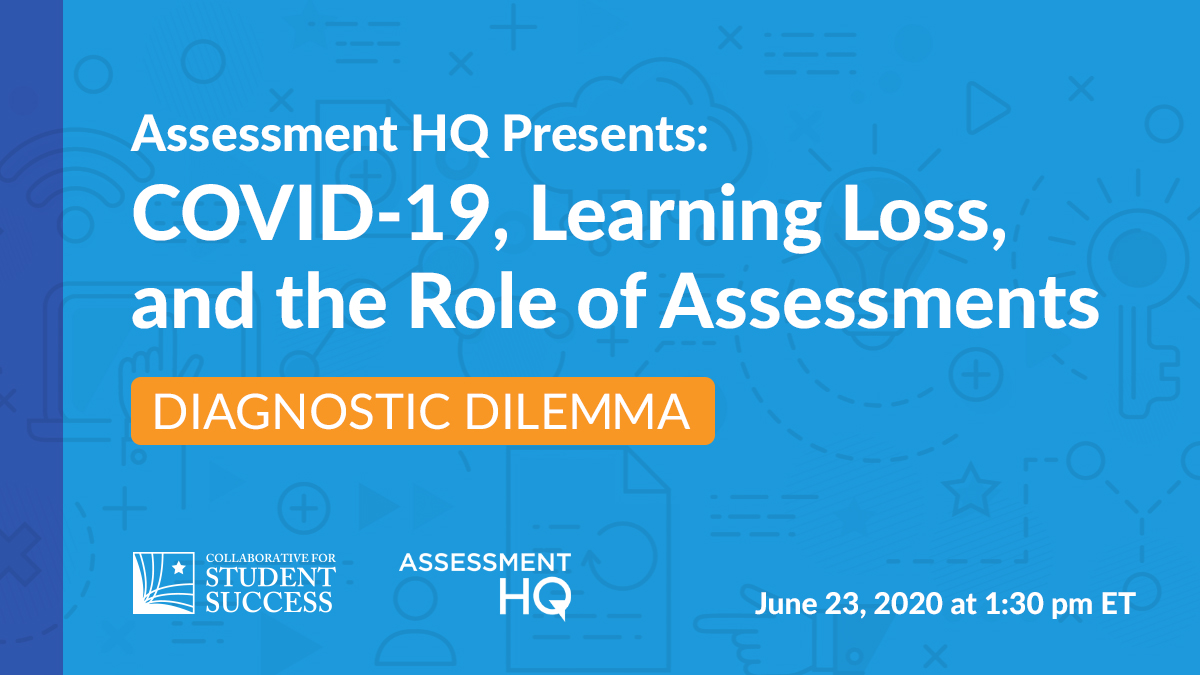RECAP: Assessment HQ Presents Diagnostic Dilemma – June 23, 2020

There’s value in using diagnostic assessments to gauge where students stand academically when the new school year starts, panelists told Dale Chu, author of Assessment HQ’s Testing 1-2-3 blog, during an online conversation on June 23.
The discussion was the second of three organized by Assessment HQ, a project of the Collaborative for Student Success, to explore the issue of measuring learning loss amid school closures tied to the COVID-19 pandemic.
Chu was joined by Laura Jimenez, Director of Standards and Accountability at the Center for American Progress, Juan D’Brot, Senior Associate at the Center for Assessment, and Eric Becoats, Superintendent of William Penn School District in Pennsylvania. Each described a role for diagnostic assessments that are standards-aligned and curriculum-embedded but cautioned that there needs to be thought and planning to make them effective.
Becoats said such a tool can provide immediate and actionable data to educators.
“A diagnostic helps a teacher understand what they should be specifically doing in the classroom and how to utilize the info to focus student instruction,” Becoats said “A diagnostic, for example, can show a teacher how to group students according to skill and make sure they’re getting the lessons they need.”
In turn, D’Brot described how identifying gaps in student knowledge using diagnostic assessments can serve to provide an understanding of the equity implications of what’s been dubbed the “COVID Slide.” For example, he said students with disabilities and English learners are among the populations that lost access to educational services during the period of school closures and that better understanding their needs should be a high-priority issue.
D’Brot emphasized, however, that some questions must be thought through before using a diagnostic, like identifying what resources are available to schools and districts and if those accessible tools measure priority standards. He said diagnostic assessments are a powerful tool only if they are diagnosing what they were designed to address.
Jimenez urged education stakeholders to not only focus on academic attainment, but to use diagnostic data to target instructional supports in a way that increases time and resource capacity to address additional equity concerns, like access to Social-Emotional Learning resources, mental health wellbeing, as well as school meals, internet and technology, and transportation.
Jimenez said diagnostic assessments that are qualitative in nature will likely be more useful to understand where students stand – at least in the beginning.
“Even though they will take more time and effort to administer, they will yield information that’s most useful,” Jimenez said.
The panelists said students deserve access to grade-level materials and content. Although diagnostic data may reveal gaps in instruction, educators should be trained and empowered to “scaffold the learning” for students so as to address identified gaps within the context of grade-level learning, they said.
Overall, the panelists expressed optimism that schools could acquire actionable data with the use of an aligned diagnostic assessment at the beginning of the 2020-21 school year, and that such “triage” data could help inform the development of plans to allow schools to best serve their respective communities.
The panelists concluded the discussion by offering some words of advice and support for school leaders and districts: “be creative,” don’t anticipate a “silver bullet,” and invest time in identifying the resources that are already available and are closest to the learning happening for their students.
To view the full recording of the Diagnostic Dilemma webinar, click below:
About the Collaborative for Student Success
At our core, we believe leaders at all levels have a role to play in ensuring success for K-12 students. From ensuring schools and teachers are equipped with the best materials to spotlighting the innovative and bold ways federal recovery dollars are being used to drive needed changes, the Collaborative for Student Success aims to inform and amplify policies making a difference for students and families.
To recover from the most disruptive event in the history of American public schools, states and districts are leveraging unprecedented resources to make sure classrooms are safe for learning, providing students and teachers with the high-quality instructional materials they deserve, and are rethinking how best to measure learning so supports are targeted where they’re needed most.

